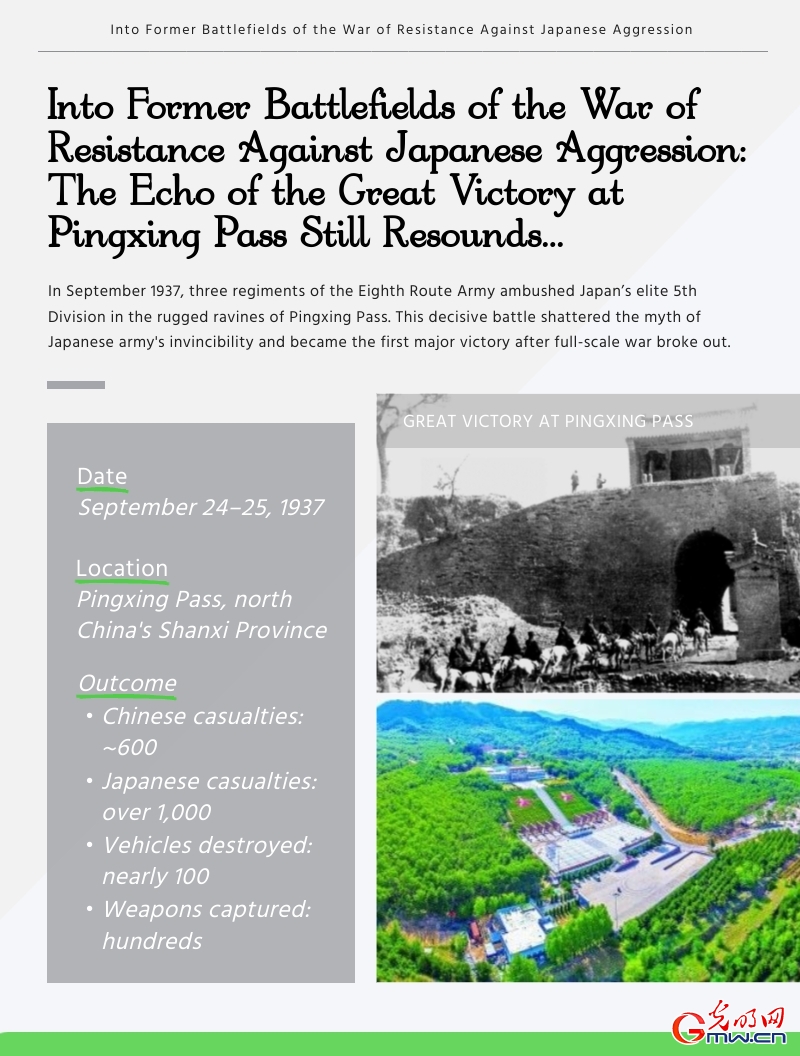


“When foreign invaders storm the borders, we sing with passion and rush to the front-lines. Our first battle was Pingxing Pass, and our name resounded throughout the world.” —Lyrics from The March of the Eighth Route Army
When people talk about the War of Resistance Against Japanese Aggression, the Great Victory at Pingxing Pass inevitably comes to mind, for its significance in Chinese military history is unparalleled.
On the midnight of September 24, 1937, in Pingxing Pass of Lingqiu County, north China’s Shanxi Province, a once-clear sky suddenly roared with fierce winds and pouring rain. Units of soldiers, dressed only in thin garments and straw sandals, advanced stealthily through the storm. Before dawn, they had silently disappeared into the mountain ravines, blending with the land, trees, and grass in silence.
These troops were three regiments of the 115th Division of the Eighth Route Army.
In 1937, after the Lugou Bridge Incident, the Japanese army rampaged through Peking and Tianjin in less than a month, looting, burning, and killing along the way...
In their plan to control North China, the Japanese needed first to take Shanxi-Suiyuan; to seize Shanxi-Suiyuan, they had to occupy Taiyuan City; and to do that, they had to pass through Pingxing Pass.
According to intelligence gathered by the Chinese forces, after capturing Datong City, the Japanese invaders aimed to break through the Pingxing Pass defenses and join forces with other Japanese units north of Yanmen Pass, with the ultimate goal of taking Taiyuan.
Pingxing Pass, located east of Yanmen Pass, lies amid rugged mountains. A narrow dirt road snakes along the bottom of the gorge, flanked by brush-covered heights ideal for concealing troops. After careful study, the Chinese forces decided to set up an ambush at Pingxing Pass to deliver a heavy blow to the enemy.
Their opponent was Japan’s elite and highly mechanized “Steel Division”—the 5th Division—which had committed numerous atrocities across China.
To ensure the best possible outcome, the division leaders surveyed the terrain three times in person. They eventually selected Qiaogou, a deep ravine before the pass, as the ambush site.
The ravine was barely 10 meters wide in places, narrowing to as little as three or four meters, with cliffs over 20 meters high on both sides—an ideal natural battlefield for an ambush.
A carefully planned “trap formation” took shape: the 685th Regiment would act as the “iron fist” to block the vanguard; the 686th Regiment would be the “sharp blade” to slice through the Japanese column; and the 687th Regiment, the “chain lock,” would cut off the enemy’s retreat, forming a deadly encirclement.
At dawn on the 25th, the sky cleared. The distant rumble of engines approached. Around 2,000 troops from the Japanese 21st Brigade of the 5th Division entered the ambush zone. Over 100 trucks carrying soldiers and supplies led the way, followed by more than 200 supply vehicles.
Once the entire enemy force was inside the kill zone, a single command unleashed a storm of gunfire from the mountainsides. After several volleys, Yang Jiahua, political instructor of the 4th Company of the 685th Regiment, ordered his men to hurl grenades at the enemy. Before the smoke had cleared, he led his troops in a charge toward the road.
According to Yang's later recollection: “Our soldiers chased the panicked enemy with bayonets. Dead and wounded Japanese were everywhere.” The ambush units quickly tore the enemy into dozens of fragments. The Japanese were stunned.
Soon, they regained their senses. Their commanding officer, brandishing his sword, led the scattered troops toward the only mountain path left—Laoye Temple.
There, the 686th Regiment, tasked with sealing the encirclement, clashed fiercely with the enemy. The only sounds were clanging bayonets, the shouts of Chinese soldiers, and the screams of the Japanese. Although the Japanese dispatched planes, they could only circle above helplessly, unable to strike because the troops were locked in close combat.
Zeng Xiansheng, commander of the 5th Company, 2nd Battalion of the 685th Regiment, led 20 men in a shock assault unit armed with broadswords. He cut down several enemies before suffering severe injuries himself. When surrounded, he did not retreat—he pulled the pin on his last grenade and died with the enemy.
When the company commander fell, the political instructor took over. When the platoon leader fell, the squad leader stepped up. By the end, only 30 soldiers remained in the 5th Company. Yet Laoye Temple, the commanding height, remained firmly in our hands.
The battle raged from dawn until dusk. As the sun set, the thunderous sounds of battle finally subsided. With the last rays of sunlight fading, the Battle of Pingxing Pass came to a close. Along the 5-kilometer ravine lay the bodies of Japanese troops and the smoldering wreckage of enemy vehicles.
In this battle, the Eighth Route Army suffered more than 600 casualties but annihilated over 1,000 Japanese soldiers, destroyed nearly 100 vehicles, and captured hundreds of weapons.
The victory at Pingxing Pass was the first major battle won by Chinese forces after the full-scale outbreak of the war and shattered the myth of the Japanese army’s invincibility. As Chairman Mao Zedong remarked, “The significance of Pingxing Pass lies in its power as a political mobilization.”
Eighty-eight years have passed, once again spring has returned to the land. Under warm sunlight, reporters from Guangming Daily revisit the former battlefield of Pingxing Pass.
Qiaogou lies silently in the distance. Fresh green willow branches sway gently, as if whispering the legends that unfolded on this land.
Liu Xiaoyu, a docent at the Pingxing Pass Victory Memorial Hall, told the reporters: “The Eighth Route Army’s victory wouldn’t have been possible without the villagers’ support. Locals served as guides, delivered food, carried stretchers, and even helped transport captured supplies. The ambush site was chosen with the help of a local villager named Zeng Huai from Baiyatai Village.”
The reporters visited Baiyatai Village.
At the village entrance, a red banner across a blue-brick house proudly declared: “The news of the Great Victory at Pingxing Pass was broadcast to the world from here!” Walking along the village road, the reporters passed a cliff lined with evergreens and a row of yellow-topped cave dwellings. In front of the caves, a welcoming square paved with white stone slabs featured two large red gates with hollowed centers.
Shi Tianchi, the village’s First Party Secretary, explained: “That gate is called the Gate of Victory. The cave behind it once hosted the 115th Division’s leadership. Another nearby cave served as the confidential communications office. Baiyatai is among the first nationally designated ‘Beautiful Red Villages.’ We receive over 300,000 tourists annually. Many villagers now run restaurants and guesthouses using the village’s revolutionary heritage.”
As he spoke, tourists with non-local accents passed by.
Shi then led the reporters to a courtyard in the village—a bag manufacturing workshop. Dozens of workers were cutting fabric, sewing leather, and installing zippers—everyone was hard at work.
Shi pointed to a young man hurrying back and forth. “His great-grandfather, Zeng Huai, was the guide who helped the Eighth Route Army to carry out that ambush.”
The young man introduced himself as Zeng Kefeng. He said that just as his great-grandfather had helped defeat the Japanese invaders alongside the Eighth Route Army, the Communist Party had now led the villagers to a better life. After leaving the army, and with government support, he started a Red-themed bag factory. “Pingxing Pass elements” became a signature feature. Once launched, the cultural products became popular with tourists. The small factory alone provided jobs for over 30 villagers.
Speaking of “Pingxing Pass elements,” Zeng Kefeng’s enthusiasm grew: “Now, many villagers make a living from the ‘Great Victory.’ To help everyone prosper, the provincial government built the ‘Great Wall No. 1 Tourism Highway’ through the village. The township constructed a Red Culture theme market called ‘Pingxing Pass Post Station,’ bringing together all the villagers’ local products. Look—every shop sign has ‘Great Victory’ on it. The farm produce boxes say ‘Great Victory,’ and even the paper cuttings, tiger pillows, and straw paintings feature ‘Great Victory elements’...”
Zeng’s voice grew more spirited as he went on: “The Eighth Route Army fought and won back then to give us this peace today. We must carry their spirit forward—just like them, we must take the initiative and win the battle for rural revitalization!”
Find the original article at https://news.gmw.cn/2025-04/05/content_37948461.htm
Written by Li Jianbin and Yang Yu, Guangming Daily
Translated by Wang Xinyuan
点击右上角![]() 微信好友
微信好友
 朋友圈
朋友圈

请使用浏览器分享功能进行分享
